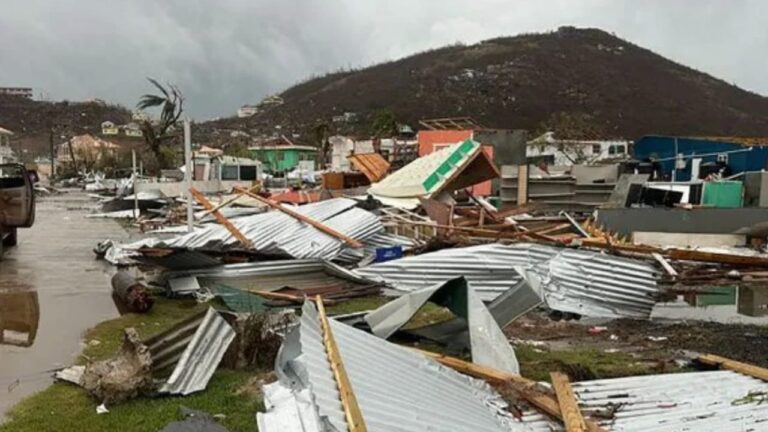Could a “flying piano” help transform the air cargo market?
US start-up Aerolane is looking for the secrets of air surfing.
Geese already know how to do it: when you see them flying in a V formation, they ride the air currents created by the other flight mates in front and around them.
At an airfield in Texas, Todd Graetz wants to shake up the air cargo market with this concept.
Aerolane imitated the tricks of migratory birds, using a modified aircraft towed into the air by another aircraft.
Smoke rising from the lead aircraft allowed a camera mounted on the towing aircraft to capture vortices in the air that the glider could use to stay airborne.
Their latest test aircraft is known as the “Flying Piano” because of its poor gliding characteristics.
Two engines idle to generate electricity while the propellers spin to glide for purely aerodynamic reasons.
Other tests measured the tension on the tow line.
They noticed when the line went slack, showing that the glider was surfing a current created by an aircraft flying in front.
Aerolane plans to feed all this data into a program that would pilot the unmanned cargo aircraft through wakes and turbulence, taking advantage of its ability to travel long distances without using fuel.
Such a cargo aircraft could be towed to its destination by a jet aircraft also carrying cargo, and land autonomously.
The only fuel cost would come from supplying the tow plane’s engines.
In theory, this would work like a truck towing a trailer, with the air currents doing much of the heavy lifting. Graetz calls this a “combination of gliding and surfing.”
Airbus came up with the same idea and tested the technology in 2021 with two A350 aircraft, flying a distance of 3 km over the Atlantic Ocean.
Although the aircraft were not connected by towing, the experiment saw one aircraft benefit from the towing of the leading A350, reducing CO2 emissions and fuel consumption.
Graetz, a pilot with 12 years of experience, co-founded Aerolane with Gar Kimchi, a veteran of Amazon’s drone delivery project, because “there must be a better way to make more use of existing aircraft.”
The project caused consternation among experienced pilots. Flying large gliders in commercial airspace requires compliance with strict aviation safety regulations.
For example, the tow plane must have confidence that it can release the tow line at any point during the flight and that the autonomous glider can reach the runway without falling on locals.
Aerolane says that small electric motors driving the propellers will act as a safety net for the cargo glider, providing enough power to redirect it to another direction or another nearby location if it fails to land.
Graetz counters that Aerolane employs active commercial pilots who are keeping a cool head on the practical aspects of the project.
“We’ve hired outside consultants to be devil’s advocates,” he adds.
He says that big shipping companies are interested in anything that can reduce their cost per delivery.
In addition to fuel costs, air cargo companies also have to consider engine emissions and pilot shortages.
Former RAF helicopter pilot and aviation consultant James Earle believes Graetz is on to something.
“There are obvious advantages to be gained from slipstreams and collaboration in the air, and any innovation in cargo is a good thing.”
But he warns that public acceptance of unpowered cargo flights over urban areas is another matter entirely.
“The tow plane must have sufficient runway to reach a landing site in the event of a serious fault in the tow plane. But whether this will be communicated effectively to the public is another matter.
Regulators are also likely to be cautious, especially in the United States, where the Federal Aviation Administration (FAA) is under pressure following serious problems with Boeing aircraft.
Graetz responded that his team has so far complied with all the requests from the FAA. “The FAA has always been extremely risk averse. This is their business!”
Fred Lopez worked in the aviation division of cargo giant UPS for 36 years. As he says, he has spent “his entire adult life” trying to find the most cost-effective way to run the air cargo business.
Lopez admits he was very skeptical of cargo gliders when Aerolane first approached him. But the prospect of significant fuel savings convinced him, and he now serves on the advisory board.
Reducing fuel costs is a top priority in commercial aviation; airlines have reduced fuel costs by about 5 percent since upturned wingtips visible through cabin windows became a standard design feature.
But gliders only use as much fuel as a towplane would need. Even if it’s a cargo plane, a pair of gliders towed by a jet means significantly less fuel burn for large cargo.
Aerolane’s original design uses what Lopez calls a human “safety pilot” in addition to the autopilot, which should make certification by the FAA easier.
“Aerolane isn’t trying to change everything at once,” he says.
Their ultimate goal is autonomous flight using artificial intelligence, or, in Lopez’s words, “taking the pilot out of the seat.”







